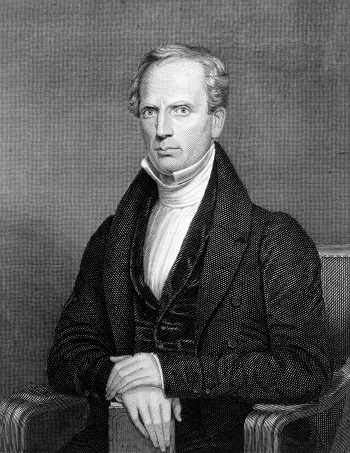
Jefferson County, New York, was the location
where Charles G. Finney began his ministry
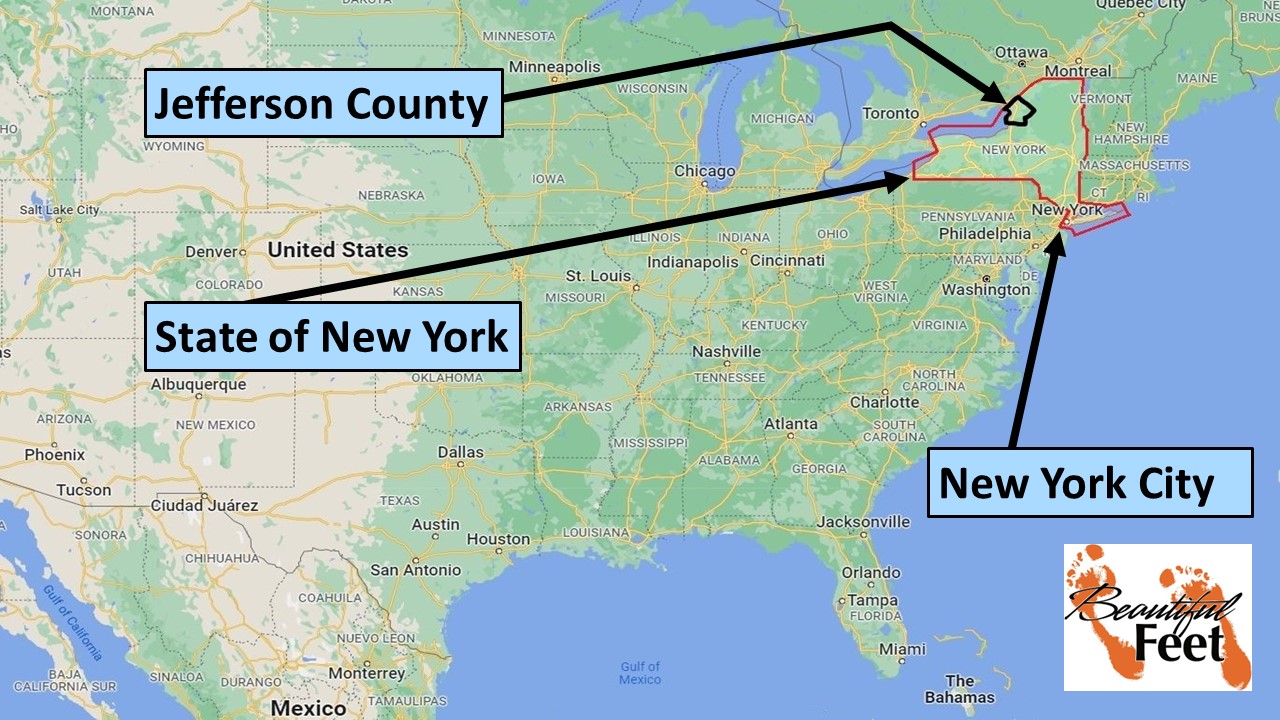
Jefferson County, New York, is outlined in black
Preliminary Reading
To help with the historical context, we recommend reading about the revivals that had been previously occurring in other New England states. Those revivals can be read with these accounts:
► 1790-1840 Second Great Awakening
► 150 New England Revivals (1797 – 1814)
► 1815-1840 Upstate New York Revivals
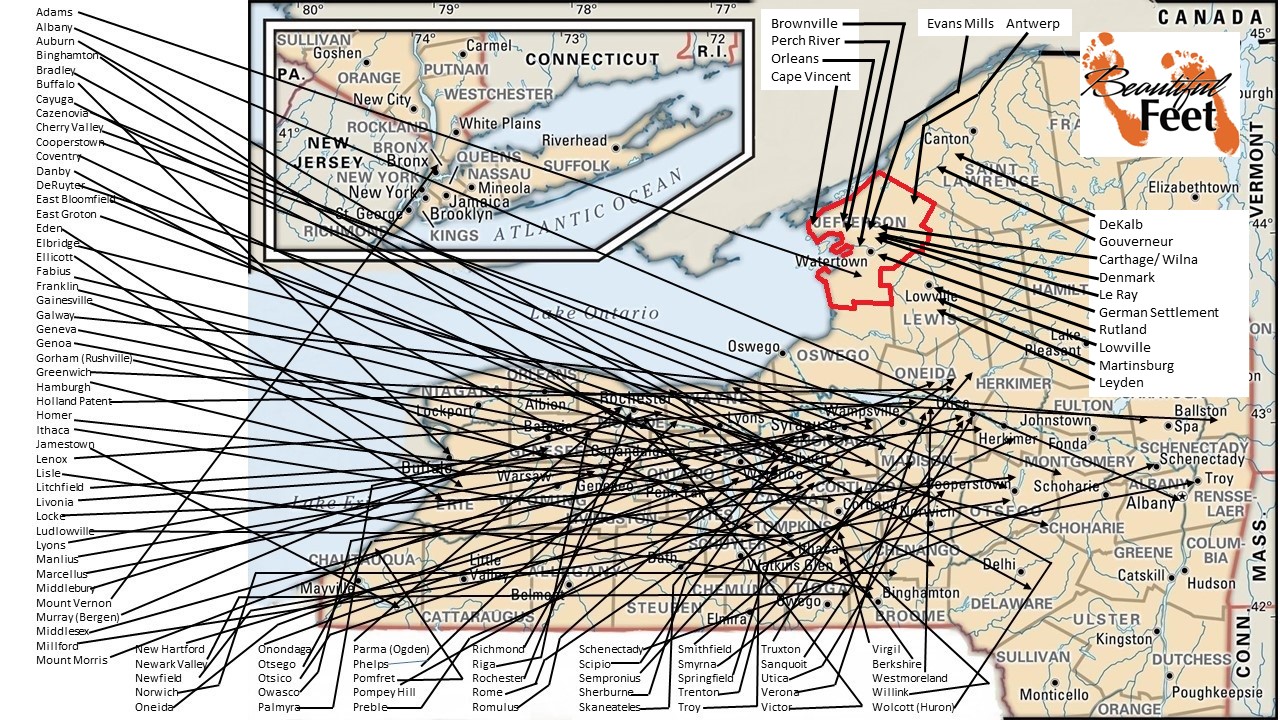
State of New York: Jefferson County is highlighted in red. The black lines indicate locations where the revival spread over the next decade. The area became known as the “Burned-Over District.”
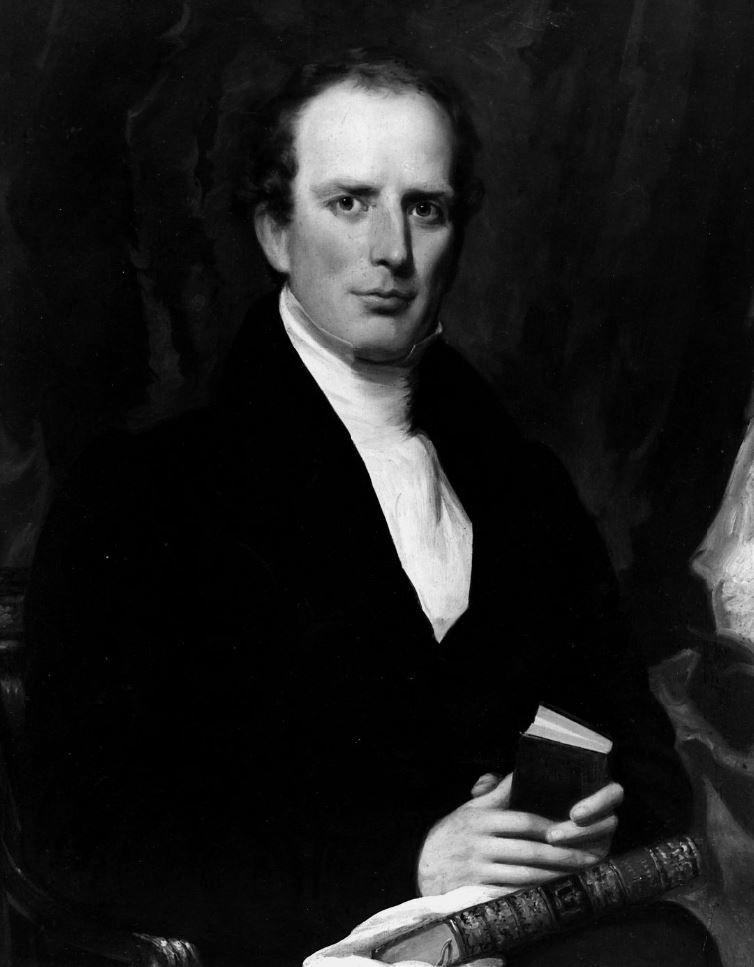
Charles Grandison Finney – Father of modern revivalism
and the leading figure of the Second Great Awakening
Introduction
Charles G. Finney (1792-1875) was raised in Oneida County, New York, which at that time was still considered a wilderness. There were no Sunday Schools or opportunities for religious education, leaving the people with no religious convictions. The few ministers that passed through were described as uneducated, and laughably so.
Finney’s conversion in 1821, at 29 years of age, was extremely dramatic, and was accompanied by a powerful baptism of the Holy Spirit. You can read about it here. Immediately following his conversion, he abandoned his promising career as a lawyer, and by 1824 was ordained as a Presbyterian minister. By 1827 he had “risen to national prominence as the most effective evangelist in the West.”
Being supported as a missionary by the Female Missionary Society of Oneida County, New York, Finney’s first assignment was work in Jefferson County, New York.
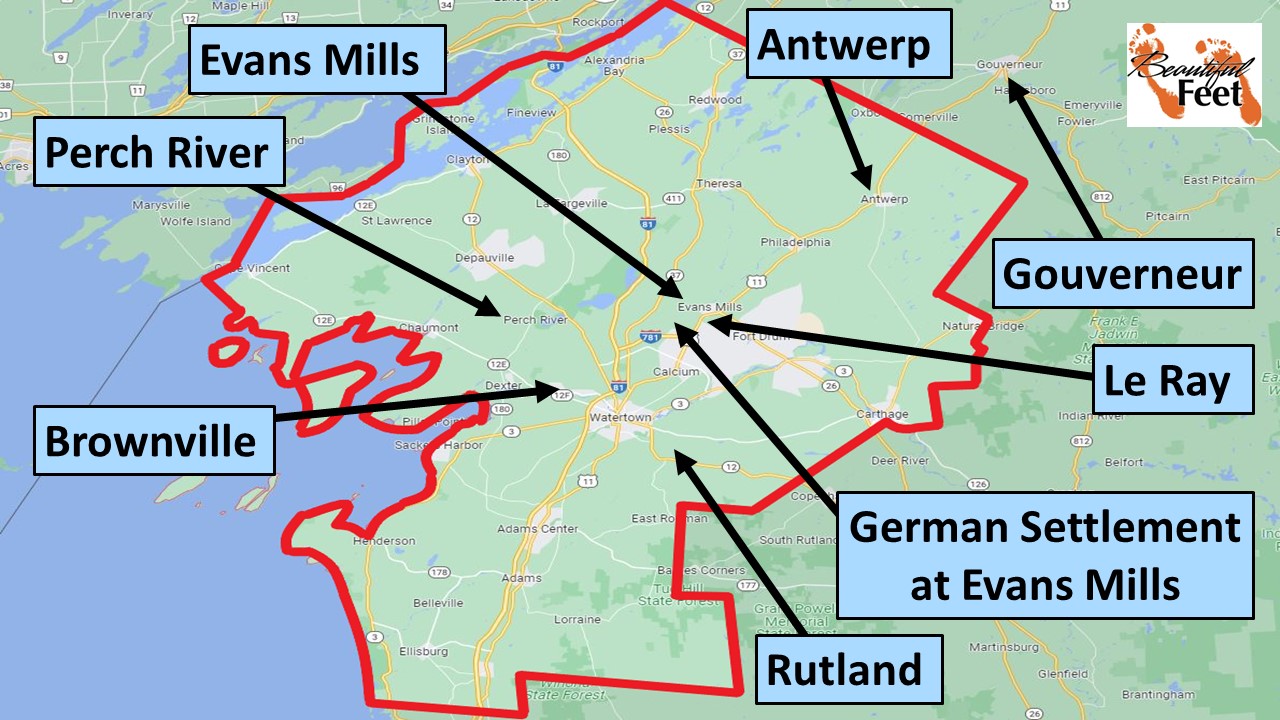
Jefferson County, New York. This shows a few of the locations where the revivals occurred during 1824-1825.
Simultaneous Revivals: Antwerp and Evans Mills
Finney’s first sermon in Evans Mills was on the last Sunday in March, 1824. The first Sunday in April he preached in Antwerp, New York, (13 miles to the northeast of Evans Mills). The second Sunday in April he was back in Evans Mills again. He spent his time like this, alternating Sundays between Evans Mills and Antwerp, till the end of September, when he concluded his ministry in Antwerp.
During the meetings he held at Evans Mills and Antwerp, there was also a significant revival that took place among German immigrants who had a settlement just outside of Evans Mills. That account can be read here.
Conditions in Antwerp
In 1824 Antwerp had a population of 2,250 people and there were no church services of any kind being held.
A rich landowner in the area, to encourage settlement around the town, built a brick meeting house for church services, but it wasn’t used.
The First Presbyterian Church was organized in July of 1819, and had 10 members, but the elder who had the key to the building, and who also conducted the meetings (Deacon Randall), lived 5 miles outside of town, and to get to the church on Sundays he had to travel through a Universalist settlement. Those people would attack him every time he tried to go to church meetings, so he stopped going, and the church stayed closed.
In Antwerp, conditions were so bad that men called it “Hell’s Acres.” All religious services had been abandoned, the enmity against preachers was so great that they even took the wheels off their carriages. By the year 1823, “all meetings were relinquished.”
Extraordinary Prayer
Finney had a practice of gathering intercessors before he did anything else in a community. When he arrived in Antwerp, at the home of a deacon, he began to take off his overcoat, and at the same time asked if there were any praying people in the town. He was told that there were three godly women, and instantly Finney said he had to see them. He immediately put his coat back on and went out to find them.
Upon speaking with the women, he asked if they wanted to have a meeting, and they said they did. One of the women opened her home for a service that evening and 13 assembled. After preaching to them, Finney told them he would preach at the schoolhouse on Sunday if permission would be granted. They got access to the school and the word went out about the Sunday service.
While in town on Saturday, Finney heard a lot of profanity on the streets, and he said that
The very atmosphere seemed to me to be poison; and a kind of terror took possession of me.
As he spent the rest of the day in prayer, he received assurance from God:
Be not afraid to speak, and hold not thy peace; for I am with thee, and no man shall set on thee to hurt thee. For I have much people in this city.
Though Finney had no fear, the Christians in town did have fear of starting up services again, as violence was threatened coming from Universalists, Deists, and “revilers of religion.”
Leaving the hotel where he was staying, on Sunday morning he went to a wooded area outside the town, and after about 2 hours of agonizing prayer, he finally sensed relief and went to the schoolhouse for the meeting.
Sunday Service at the Schoolhouse
The schoolhouse was filled to capacity for Finney’s first service there, and preaching from John 3:16, Finney, through his own tears, called out the very men he had heard the day before cursing each other on the street. The people knew that what he was saying was true, and it sent fear into many people’s hearts.
They did not appear offended; but the people wept about as much as I did myself. I think there were scarcely any dry eyes in the house.
Afternoon Service at the Church Building
The Presbyterian Church wasn’t allowed to be used that morning, but after seeing the effects of the preaching, it was opened for an afternoon meeting. As people left the morning service at the schoolhouse, they immediately went throughout the town telling others of the planned meeting later that day, and when Finney arrived for that service, he found the building packed.
About that service, Finney said,
My preaching seemed to be something new.
I felt like rebuking them with all my heart, and yet with a compassion which they could not mistake.
The labors of this day were effectual to the conviction of the great mass of the population.
Revival Fires Burning
Following that Sunday, wherever Finney would preach—in homes, open air, schoolhouses, or the church—“the people would throng to hear.”
Preaching in Sodom
After three Sundays of preaching in Antwerp, an elderly man requested Finney to come to his area and preach at their schoolhouse, which was located 3 miles outside the town. The man told Finney that they had never had any religious meetings in their area. Finney then agreed to come the following day, Monday.
The next day, upon arrival at the schoolhouse, Finney found the place filled, with standing room only. After Finney led in the singing of a hymn, he fell to his knees and began to pray. It was then that he felt:
The Lord opened the windows of heaven and the Spirit of prayer was poured out, and I let my whole heart out in prayer.
Not being accustomed to writing out sermons, nor having a text prepared ahead of time, he arose from his knees from where he was praying and spontaneously, and unscripted, said:
“Up, get ye out of this place; for the Lord will destroy this city.”
That was a quote from Genesis 19:14, the story of Sodom and Gomorrah. Finney then began telling that story, and he noticed that the people’s faces began to express anger toward him, but he didn’t understand why.
In less than 15 minutes into his sermon, something powerful occurred:
Some thing flashed over the congregation,—a kind of shimmering, as if there was some agitation in the atmosphere itself. The congregation began to fall from their seats; and they fell in every direction, and cried for mercy. If I had had a sword in each hand I could not have cut them off their seats as fast as they fell. Indeed nearly the whole congregation were either on their knees or prostrate, I should think, in less than two minutes from this first shock that fell upon them.
It was hard to get the people’s attention because they were so overcome with their conviction of sin. Finney then spoke out as loud as he could:
You are not in hell yet; and now let me direct you to Christ.
Yet, with all his effort he could not get their attention. Then a joy began bubbling up out of his inner being because of being a witness to such a powerful move of the Holy Spirit. Of that occasion, he wrote:
My heart was so overflowing with joy at such a scene that I could hardly contain myself A little way from where I stood was an open fire-place. I recollect very well that my joy was so great, that I could not help laughing in a most spasmodic manner. I knelt down and stuck my head into that fire-place, and hung my pocket handkerchief over my head, lest they should see me laugh; for I was aware that they would not understand that it was irrepressible, holy joy that made me laugh. It was with much difficulty that I refrained from shouting, and giving glory to God.
After praying with several people individually, Finney turned the service over to the elderly man who invited him to come. The meeting continued till the next morning, as there were many under such conviction of sin that they could not physically walk—they had to be carried to a home so the school could use the building that morning.
The second time Finney went to that location he found out why they had looked so angrily toward him when he was preaching about Sodom and Gomorrah, and it was because that location was so wicked it was called “Sodom,” and they called the elderly man who had invited him to preach there, “Lot.”
Outpouring of the Holy Spirit among Universalists
Finney was then invited to preach in the Universalist community outside of Antwerp. This was among the people previously mentioned, that prevented Deacon Randall from passing through their area on his way to Antwerp to open the Presbyterian Church for Sunday services. The results of the ministry in that small community were just as powerful as in Sodom, as Finney relates:
It was a scene that almost equaled that of which I have spoken in Sodom. The revival penetrated every part of the town, and some of the neighboring towns shared in the blessing. The revival was very precious in this place.
Instantaneous Recovery of the Demonized
On a Sunday afternoon, as Finney walked into the Antwerp church, he noticed several ladies sitting in a pew holding a woman, preventing her from leaving. They told Finney that she had been a Methodist, but that she had “fallen from grace,” which had led to her despair, and finally into insanity.
The “insane” woman told Finney that she couldn’t endure any praying, preaching, or singing, and that she couldn’t tolerate anything that made her think of heaven.
Finney told the women to hold her while he went to the pulpit. As he opened a hymnal and began singing, the woman fought to get free and leave—but was restrained.
The text Finney then read was from Hebrews, about entering the throne of grace to obtain mercy (Hebrews 4:16). The woman again began to fight to break free and leave, but she was held in place. Then, the woman,
…startled the congregation by uttering a loud shriek, she then cast herself almost from her seat held her head very low & I could see that she ‘trembled very exceedingly.’ The ladies in the pew with her partly supported her… As I proceeded she began to look up again & soon sat upright with face wonderfully changed, indicating triumphant joy and peace. There was such a halo upon her countenance as I have seldom seen in any human face. Her joy was so great that she could scarcely contain herself till meeting was over, and then she soon made everybody understand around her that she was set at liberty. She glorified God, and rejoiced with amazing triumph. About two years after, I met with her, and found her still full of joy and triumph.
A second lady from that town, “who had also fallen into despair and insanity,” was delivered “almost or quite instantaneously,” and it was said to have been “by means of a baptism of the Holy Spirit.”
New Pastor and Results of the Revival
In the fall of the year, Finney arranged for Rufus Romero Deming (1792-1868) to come and pastor the thriving Presbyterian congregation. There were 16 members in the church when Finney arrived in April 1824, and when he left in October 1824, the membership was 101.
Methods Finney Used in the Promotion of the Revival
► Daily preaching—focusing on solid doctrinal truths—using homes, barns, schoolhouses, and the open air
► Conducting protracted meetings (revival services) over a period of days or weeks
► Private and corporate prayer meetings
► Teaching conferences
► A lot of personal conversation by making personal visits to homes
► Meetings with those inquiring about the condition of their souls
► Encouraging the immediate reception of new converts as members in churches
► Allowing women to pray and exhort during church services
► Utilizing women’s prayer groups to capitalize on existing social networks for evangelism
► During his sermons those who felt the conviction of sin and their need of a Savior were invited to come to the front to sit in the pew reserved for them. This pew was called the “anxious seat.” Others have termed this the “mourners’ bench.”
► Praying for people publicly by name
Opposition from Ministers
One of the criticisms Finney received from other ministers was the simplicity of his sermons, as he would frequently use illustrations from daily life: farming, mechanics, and any occupation. He would also use language that common people would understand—without them having to use a dictionary to understand his vocabulary—something quite different from other ministers.
The ministers said Finney would never be able to convert the more educated people in the community by preaching like that, but they were wrong, as judges, lawyers, and others of the educated class converted through his ministry.
Another major criticism was about permitting women to play an active role in ministry, as Finney encouraged them to:
► Pray and exhort during church services.
► Evangelize and conduct prayer meetings outside church services.
Finney Revival Account List
Access all accounts of Finney’s revivals using this link.
Primary Sources
► Chapter VIII Revival at Antwerp: The Memoirs of Charles G. Finney by Charles G. Finney
► The Memoirs of Charles G. Finney: The Complete Restored Text by Charles G. Finney
Secondary Sources
► Charles G. Finney by Wikipedia
► Charles Grandison Finney & the Second Phase of the Second Great Awakening by Christian History Institute
► Eerdman’s Handbook to Christianity in America by Mark A. Noll
► Fire From Heaven by Robert Evans
► Great Revivals and the Great Republic by Warren Candler
► History of the First Congregational Church of Antwerp by New York Genealogy
► Man of Like Passions: The Life Story of Charles Grandison Finney by Richard E. Day
► Memoirs of Revivals of Religion by Charles G. Finney
► Memoir of the Life and Character of Rev. Asahel Nettleton by Bennet Tyler
► The Memoirs of Charles G. Finney Chapter VI by Charles G. Finney
► New England Revivals by Bennet Tyler
► Second Great Awakening by Wikipedia
Return to List of Revival Stories
Chet & Phyllis Swearingen:
Office: (260) 920-8248
romans1015@outlook.com
Beautiful Feet
P.O. Box 915
Auburn, IN 46706

